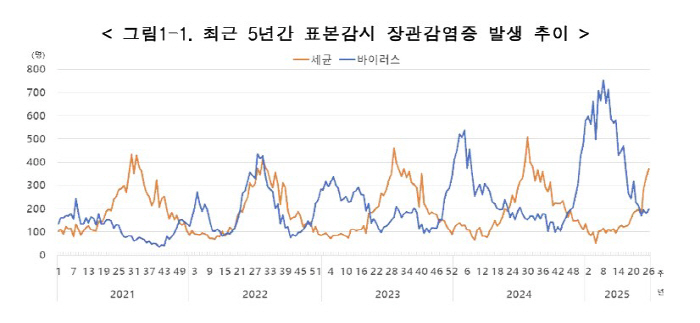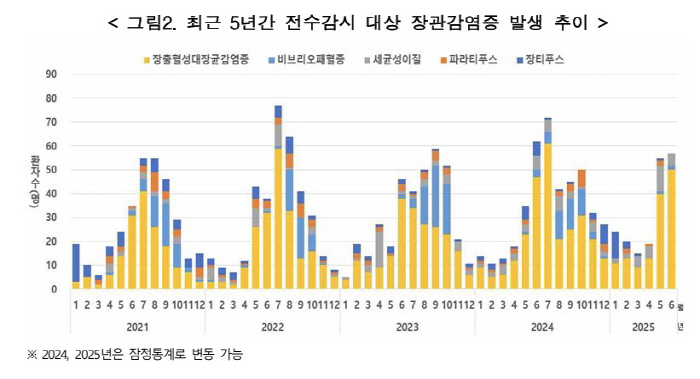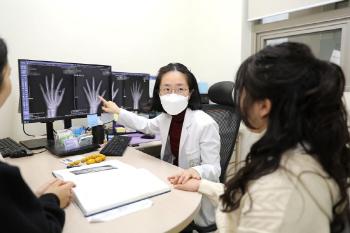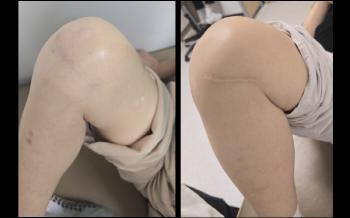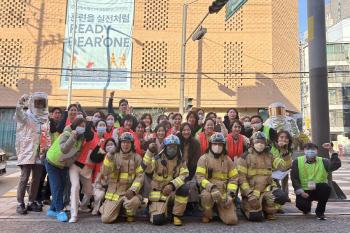Salmonella and Campylobacter bacteria spread in the scorching heat...What are the rules for preventing intestinal infections?
|
According to the Korea Centers for Disease Control and Prevention, the number of intestinal infections has been on the rise over the past five years (21-25 years) in the results of sample monitoring of intestinal infections involving hospital-level medical institutions (210 locations) with more than 200 beds nationwide.
In particular, it has been reported that the incidence of cases caused by Salmonella and Campylobacter has continued to increase over the past four weeks. The number of patients with Salmonella infection surged 92.4% from 66 in the first week of June to 127 in the fourth week, while the number of patients with Campylobacter infection also increased 2.2 times from 58 to 128.
Salmonella infection, an acute gastroenteritis caused by infection with non-typhoidal Salmonella, mainly shows symptoms of convulsive abdominal pain, fever, nausea, vomiting, and headache 6 to 72 hours after bacterial infection, and diarrhea lasts for several days, which can lead to dehydration. Rarely urine, blood, bones, joints, brain, central body
It can progress to invasive Salmonella infection as a boundary. Eggs may be infected through cross-contamination when left at room temperature for a long time, or when preparing food ingredients without washing hands after touching eggs contaminated with salmonella. Since the surface of the eggshell is often contaminated with salmonella, the shell should be purchased and refrigerated, heated and cooked sufficiently within a short period of time after breaking the shell, and washed hands after touching the egg.
Campylobacter infection is an infectious disease caused by Campylobacter bacteria and is one of the most common causes of diarrhea disease. Infected patients usually have diarrhea, fever, and abdominal cramps. Diarrhea can be accompanied by nausea and vomiting. These symptoms usually begin within 2 to 5 days of exposure and last about 1 week. It is known that 5% to 20% of patients with Campylobacter infection develop irritable bowel syndrome, 1% to 5% arthritis, and 0.1% cause Guillain-Barre syndrome (GBS). It is infected by eating undercooked meat (especially poultry), non-sterile dairy products, and contaminated water or food, and Campylobacter bacteria can be present on the surface of raw chickens, which can cause cross-contamination during food preparation such as washing. Therefore, it is better to wash raw chicken at the end of cooking, and be careful not to contaminate other ingredients by splashing water. In addition, when storing poultry, if you put it in an airtight container and store it at the bottom of the refrigerator, contamination with other foods can be reduced.
|
Enterohemorrhagic E. coli infection can be transmitted from person to person through food or water such as beef, raw vegetables, and dairy products contaminated with enterohemorrhagic E. coli. Infections are accompanied by severe convulsive abdominal pain, nausea, vomiting, and mild fever, and diarrhea varies from watery to bloody diarrhea. Symptoms generally improve within 5-7 days, but when they progress, the fatality rate reaches 3-5% due to complications such as hemolytic uremic syndrome. To prevent enterohemorrhagic E. coli infection, hygiene rules such as hand washing should be observed, and safe cooked food such as beef and vegetables should be consumed, such as sufficiently cooked or sufficiently washed under running water.
Vibrio septicum lives mainly in a wide range of coastal marine environments, including seawater, mudflats, and fish and shellfish, and is known to multiply when the sea temperature is above 18℃. As a result, the first patient occurs mainly from May to June every year, and the most common occurs from August to September.
Vibrio sepsis is accompanied by symptoms such as acute fever, chills, low blood pressure, abdominal pain, vomiting, and diarrhea, and skin diseases such as rash, swelling, and blisters occur within 24 hours of the onset of symptoms, so if you experience these symptoms, you should visit a hospital immediately for proper treatment.
In particular, people with underlying diseases such as chronic liver disease, diabetes, and alcohol dependents are at high risk of infection and death of vibrio sepsis, so if there is a wound on the skin, avoid contact with seawater and eat fish and shellfish cooked.
Ji Young-mi, Director of the Korea Centers for Disease Control and Prevention, said "As temperatures are expected to be higher than usual this summer, special attention is needed to prevent intestinal infections."In addition to following the rules for preventing infectious diseases such as safe food intake and proper hand washing, if two or more people experience suspected symptoms such as diarrhea or vomiting after eating the same food, please immediately report it to the nearby public health center."
This article was translated by Naver AI translator.
